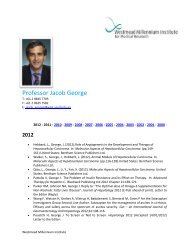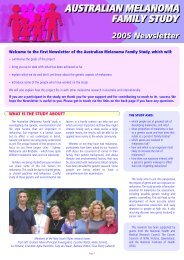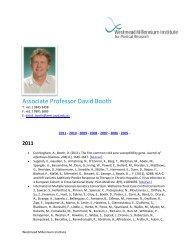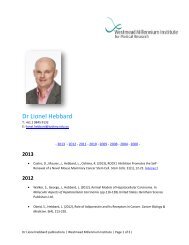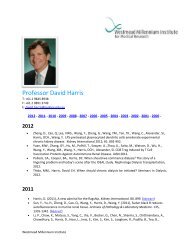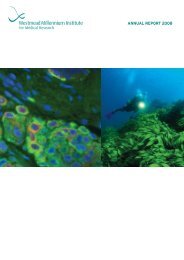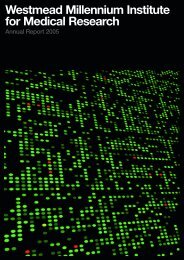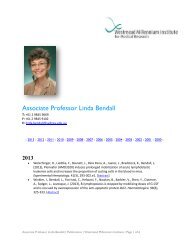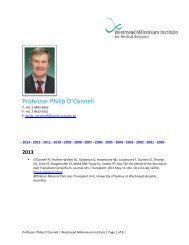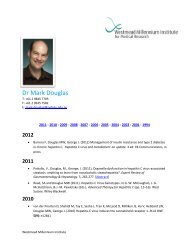Translating >> - Westmead Millennium Institute
Translating >> - Westmead Millennium Institute
Translating >> - Westmead Millennium Institute
- No tags were found...
You also want an ePaper? Increase the reach of your titles
YUMPU automatically turns print PDFs into web optimized ePapers that Google loves.
14 15 > Overview // AR 2006<br />
Cancer<br />
00.005.0483 00.005.0484<br />
The Cancer division conducts groundbreaking laboratory<br />
and clinical investigations into cancers common to<br />
Australians to improve prevention and treatment strategies<br />
and to establish new cures.<br />
The <strong>Westmead</strong> <strong>Institute</strong> for Cancer Research bases its<br />
research on the notion that if discoveries can be made to<br />
understand the faults in the wiring of cancer at a molecular and<br />
cellular basis - and how this differs from the make up of healthy<br />
cells - then medical science can develop ways to correct the<br />
defects.<br />
One of the difficulties researchers face is a lack of suitable<br />
human cancer research models. An outstanding success this<br />
year has been the development of a three-dimensional model<br />
of normal breast tissue. This model is enabling researchers<br />
to grow tiny spheres of cells taken from breast tissue in a<br />
highly organised structure, which is more closely aligned<br />
physiologically to the human system than traditional cell culture<br />
or animal models.<br />
In using the model, researchers are unraveling the process of<br />
how breast cells become cancerous through the actions of<br />
the ovarian hormones oestrogen and progesterone. Major<br />
advancements are already in play with researchers identifying<br />
pathways these hormones control within the normal breast<br />
cells. As work progresses, researchers hope to identify the<br />
normal breast cell targets that control the interaction between<br />
the ovarian hormones and cancerous cells to produce suitable<br />
prevention strategies.<br />
00.005.0490 00.005.0485 00.005.0487 00.005.0486 00.005.0459 00.005.0458<br />
46<br />
The <strong>Institute</strong> hosts the newly opened Breast Cancer Tissue<br />
00.005.0463<br />
46<br />
Bank. The bank has begun collecting breast cancer tissue<br />
samples from hundreds of women with breast cancer across<br />
NSW. This is a major achievement made possible through the<br />
cooperation of clinicians and patients. Data from the samples<br />
will be carefully linked back to the women’s follow up treatment<br />
and outcomes and researchers from all over Australia will have<br />
access to the bank to improve investigations into the disease.<br />
Cancer researchers Rick Kefford and Graham Mann are the<br />
determine the genetic signatures that make particular melanoma<br />
tumours behave aggressively using modern gene expression<br />
and microarray technology. Researchers hope to develop new<br />
treatments that target molecular faults within the cells to improve<br />
diagnosis and prognosis of this disease, enabling clinicians to give<br />
patients better treatment and advice.<br />
00.005.0482 00.005.0481<br />
Of all human cancers melanoma is most resistant to current<br />
therapies and it is an area where researchers are also using gene<br />
expression analysis (examining how genes operate within a cell)<br />
to produce better treatment outcomes for patients. The <strong>Institute</strong><br />
is investigating features in the few melanomas that are sensitive<br />
to treatment as a basis for developing techniques to breakdown<br />
the disease’s resistance to chemotherapy.<br />
Ovarian cancer is the most lethal gynaecological cancer. Each<br />
year, more than 1,000 women in Australia are diagnosed and<br />
more than 800 women die from the disease. Overall survival<br />
rates are low with only about 45 per cent of women free of the<br />
malignancy after five years.<br />
00.005.0465 00.005.0466<br />
51<br />
00.005.0462<br />
Most ovarian cancers are initially sensitive to chemotherapy.<br />
However, the most common outcome for women with this<br />
disease is for it to return within a couple of years and, when<br />
the patient relapses, the cancer is most often resistant to<br />
chemotherapy. There are however, a small group of patients<br />
that respond extremely well to chemotherapy and are essentially<br />
cured. Researchers in the Gynaecological Cancer Research<br />
Group are trying to identify why some patients respond so<br />
much better to treatment than others in the hopes of developing<br />
new therapies based on gene targeting.<br />
They have already identified one gene that may be used to<br />
increase response to chemotherapy and this work has led to an<br />
international patent. The researchers have found tumours that<br />
express a lot of this gene tend to do worse, and that this gene<br />
is over-expressed in ovarian cancer cells which are resistant to<br />
treatment. (Expression is the process of a gene’s DNA sequence<br />
being converted to proteins within cells.) The group is now<br />
investigating methods to decrease the gene’s expression using<br />
a novel technique called siRNA, which specifically targets the<br />
Most cancers are due to genetic changes that accumulate in the cells with<br />
leading chief investigators on a five-year NHMRC Program gene. The aim is to then apply conventional chemotherapy<br />
age, but in 5 to 10 per cent of cases, patients have a family history of multiple<br />
Grant and a Cancer <strong>Institute</strong> NSW Translational Program grant, to improve a patient’s response to treatment. Pre-clinical<br />
cases of early-onset cancer. Many patients are enrolled in collaborative,<br />
both of which commenced in 2006. These cement long-standing experiments are underway with a commercial partner being<br />
00.005.0491 00.005.0492 00.005.0488 00.005.0489 00.005.0460 00.005.0461 collaborations with 00.005.0468 the Sydney Melanoma Unit 00.005.0469 – the largest sought to 00.005.0516 develop methods to target this 00.005.0517 gene. The group is also 00.005<br />
genetic-epidemiological studies investigating the familial aspects of cancer.<br />
28 26<br />
melanoma treatment centre in the world. The programs aim to investigating other genes with similar characteristics to possibly<br />
extend the treatment base.<br />
00.005.0464 00.005.0515



